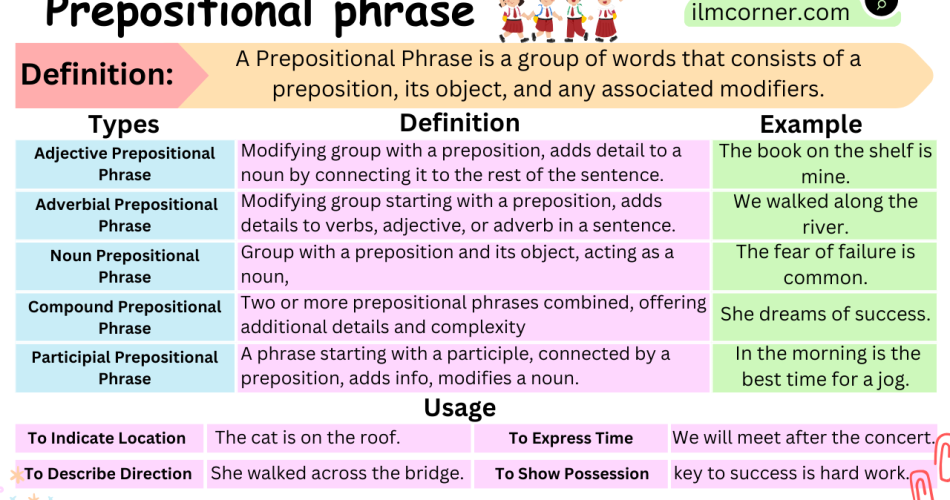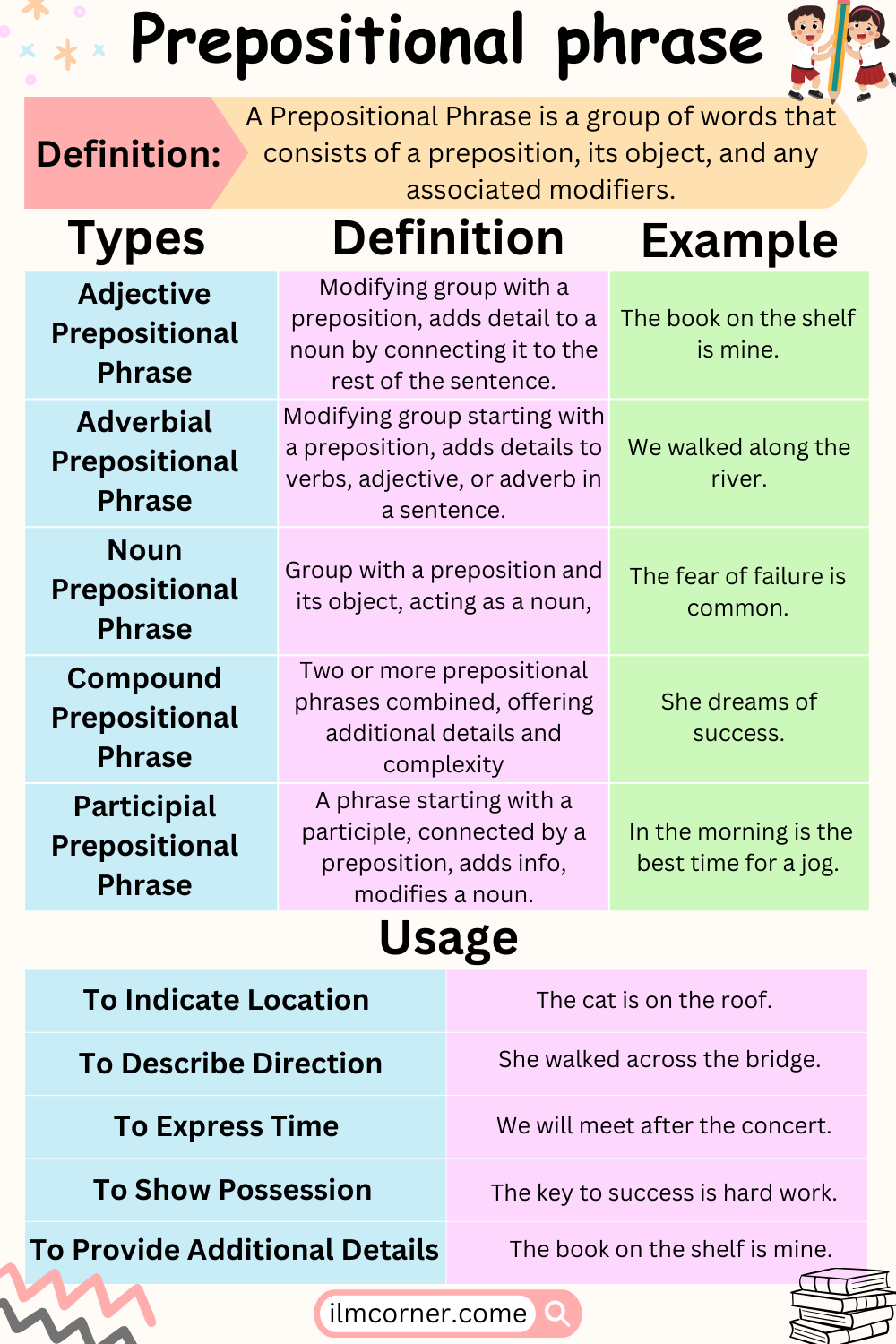A Prepositional Phrase is a group of words that consists of a preposition, its object, and any associated modifiers. The preposition, typically indicating a spatial, temporal, or logical relationship, connects with a noun or pronoun (the object). This combination adds detail, context, and specificity to sentences, enriching the overall meaning.
Begin your language journey by uncovering the essence of Prepositional Phrases. These phrases, formed by words like “on,” “under,” or “between,” act as guides in sentences, revealing where something is or how things relate. Picture them as sentence helpers, adding a special touch to your communication. A prepositional phrase typically includes a preposition (your guide), an object (the main thing), and sometimes extra words for details. These linguistic tools bring clarity and interest to your sentences. As we navigate the linguistic landscape together, our goal is to make understanding prepositional phrases a seamless part of your language exploration, enhancing your communication skills.
List of prepositional phrases:
- Above the clouds
- Across the river
- Along the path
- Among the flowers
- Around the corner
- At the beach
- Behind the house
- Below the surface
- Beside the lake
- Between the trees
- Beyond the horizon
- By the window
- Down the street
- During the night
- For the team
- From the top
- In the morning
- Inside the box
- Into the forest
- Near the park
Structure of Prepositional Phrases:
The structure of a prepositional phrase typically consists of three main components: the preposition, the object of the preposition, and any modifiers. Let’s break down the structure:
- Preposition: (e.g., in, on, under)
- Object: Noun or pronoun affected by the preposition (e.g., park, table, forest)
- Modifiers: Optional words that add detail (e.g., shiny, dense)
Examples:
- She walked in the garden.
- Preposition: in
- Object: garden
- The keys are on the shiny table.
- Preposition: on
- Object: table
- Modifier: shiny
- We traveled through the dense forest.
- Preposition: through
- Object: forest
- Modifier: dense
Usage of Prepositional Phrases:
Prepositional phrases, consisting of a preposition, its object, and any associated modifiers, play a crucial role in sentence structure. Here’s a practical overview of their usage:
- Providing Location or Direction:
- Example: The cat is under the table.
- Expressing Time:
- Example: We’ll meet after the movie.
- Indicating Possession:
- Example: The keys are on the desk.
- Adding Detail to Nouns:
- Example: The girl with the blue backpack is my sister.
- Conveying Manner or Method:
- Example: She completed the task with great precision.
- Showing Relationships:
- Example: The team worked in harmony.
- Introducing Adjective Clauses:
- Example: The student with whom I studied got the highest grade.
- Enhancing Verbs:
- Example: They talked about the upcoming project.
- Connecting Ideas in a Sentence:
- Example: He left without saying goodbye.
- Setting Conditions:
- Example: In case of rain, bring an umbrella.
Types of Prepositional Phrases:
Prepositional phrases help make sentences more interesting. Here are different types:
- Adjective Prepositional Phrase:
- An adjective prepositional phrase is a group of words that includes a preposition, its object, and any words that modify the object. This type of phrase acts as an adjective in a sentence, providing more details about a noun. Here’s a breakdown:
- Structure:
- Preposition (e.g., with, in, on)
- Object (a noun or pronoun that receives the action of the preposition)
- Modifiers (optional words that add more details)
- Example:
- The cake with chocolate icing is delicious.
- Preposition: with
- Object: chocolate icing
- Modifiers: None in this case, but it could be further described, like “with rich chocolate icing.”
- The cake with chocolate icing is delicious.
- Structure:
- An adjective prepositional phrase is a group of words that includes a preposition, its object, and any words that modify the object. This type of phrase acts as an adjective in a sentence, providing more details about a noun. Here’s a breakdown:
The adjective prepositional phrase enhances the noun it describes, giving more specific information about the characteristics or qualities associated with that noun.
- Adverbial Prepositional Phrase:
- An adverbial prepositional phrase is a group of words that includes a preposition, its object, and any modifiers. This phrase acts as an adverb in a sentence, providing additional information about the action of the verb, the place, or the time. Here’s a simple breakdown:
- Structure:
- Preposition (e.g., before, after, during)
- Object (a noun or pronoun that receives the action of the preposition)
- Modifiers (optional words that add more details)
- Example:
- They played soccer before the sunset.
- Preposition: before
- Object: the sunset
- Modifiers: None in this case, but it could be expanded, like “before the beautiful sunset.”
- They played soccer before the sunset.
- Structure:
- An adverbial prepositional phrase is a group of words that includes a preposition, its object, and any modifiers. This phrase acts as an adverb in a sentence, providing additional information about the action of the verb, the place, or the time. Here’s a simple breakdown:
The adverbial prepositional phrase modifies the verb by providing information about when, where, how, or to what extent the action takes place.
- Noun Prepositional Phrase:
A noun prepositional phrase is a group of words that includes a preposition, its object, and any modifiers. In this case, the phrase functions as a single unit and acts as a noun within a sentence. Here’s a concise guide:
- Structure:
- Preposition (e.g., in, on, under)
- Object (a noun or pronoun that receives the action of the preposition)
- Modifiers (optional words that provide additional details)
- Example:
- She sat on the comfortable chair.
- Preposition: on
- Object: the comfortable chair
- Modifiers: None in this case, but it could be extended, like “on the comfortable chair with a soft cushion.”
- She sat on the comfortable chair.
The noun prepositional phrase serves as a single noun, often functioning as the subject, object, or complement of a verb.
- Compound Prepositional Phrase:
- A compound prepositional phrase is a combination of two or more prepositional phrases that work together to convey additional information in a sentence. Let’s break it down:
- Structure:
- Multiple Prepositional Phrases joined by coordinating conjunctions (e.g., and, or, but)
- Each prepositional phrase consists of a preposition, its object, and any modifiers.
- Example:
- She walked across the bridge and over the hill.
- First Prepositional Phrase: across the bridge
- Conjunction: and
- Second Prepositional Phrase: over the hill
- She walked across the bridge and over the hill.
- Structure:
- A compound prepositional phrase is a combination of two or more prepositional phrases that work together to convey additional information in a sentence. Let’s break it down:
Compound prepositional phrases add complexity and detail to a sentence. They allow you to present related information about different aspects of an action or object.
- Participial Prepositional Phrase:
- A participial prepositional phrase involves the combination of a prepositional phrase with a participial phrase, creating a more detailed and nuanced expression. Let’s delve into the key aspects:
- Structure:
- Prepositional Phrase + Participial Phrase
- The prepositional phrase includes a preposition, its object, and any modifiers.
- The participial phrase consists of a participle (verb form ending in -ing or -ed), its modifiers, and complements.
- Example:
- The book on the shelf, written by the renowned author, captured my attention.
- Prepositional Phrase: on the shelf
- Participial Phrase: written by the renowned author
- The book on the shelf, written by the renowned author, captured my attention.
- Structure:
- A participial prepositional phrase involves the combination of a prepositional phrase with a participial phrase, creating a more detailed and nuanced expression. Let’s delve into the key aspects:
Participial prepositional phrases add descriptive details to a sentence, providing more information about the action or state described by the main verb.

